Kinetix22 Pre-Arrival Guide
Introduction
Thank you for your interest in the Kinetix22 sCMOS, the next generation in scientific CMOS cameras.
This is a guide to help you prepare for the arrival of the Kinetix22, ensuring that the hardware and software of both your PC and microscope/imaging system are capable of making the most of the power of the Kinetix22 and delivering your desired data. Alongside this, we also include detailed steps on setting up the Kinetix22 upon arrival, making the most of your preparations. The sections are as follows:
- Pre-Arrival
- What's In The Box?
- Setup
- Troubleshooting
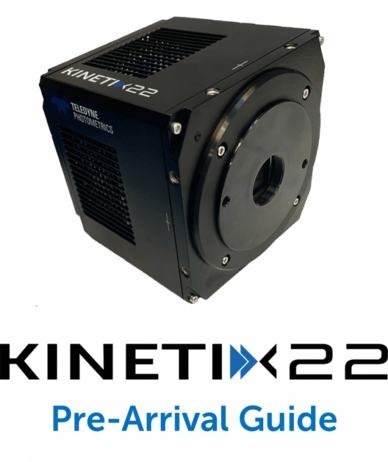
Pre-Arrival
There are four important questions to ask during pre-arrival:
- Is my PC running Windows 10?
- Does my PC have a free x8 or x16 Gen 3 PCIe slot?
- Does my PC have sufficient specifications to optimally run the Kinetix22?
Let's answer these questions!
Is my PC running Windows 10?
The Kinetix family will only run on Windows 10, earlier versions of Windows such as XP, 7, 8, and 8.1 will not be able to run the Kinetix22.
To find out if you are running Windows 10, go to Start > Settings > System > About and you should see 'Windows specifications':

Does my PC have a free x8 or x16 Gen 3 PCIe slot?
The Kinetix22 features both USB and PCI Express (PCIe) ports, and in order to achieve the maximum speeds of the Kinetix22 the PCIe interface should be used. Not all computers come with PCIe interfaces, so we supply a PCIe interface card in the Kinetix box, which attaches to a PCIe slot on your computer motherboard and allows you to use PCIe cables with the Kinetix22 and achieve maximum speeds.
However, the PCIe card only fits into size x8 or x16 PCIe slots. If your PC motherboard doesn't have an available PCIe slot or only has smaller PCIe slots (x1 or x4), then you won't be able to install the PCIe card, and won't be able to use this interface with Kinetix22.
As long as you have an x8 or x16 PCIe slot and at least 8 CPU-connected PCIe lanes available, you can reliably use the included PCIe card. Please check your computer motherboard for slots in order to use the included PCIe card and maximum Kinetix22 speeds.
The figure below details the components involved in order to use PCIe with the Kinetix22 (in blue) and some potential pitfalls (in orange).
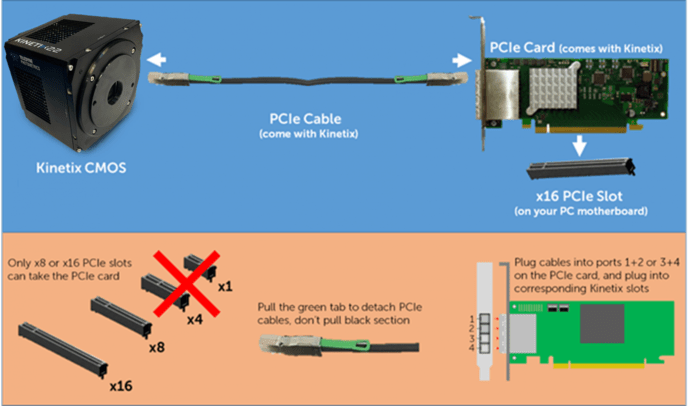
Figure 1: What to know when wanting to use the PCIe interface with the Kinetix22
If you don't need to operate the Kinetix22 at high speed, the alternative is USB. Again, we supply the latest USB 3.2 Gen2 cables (10 gigabits per second (Gb/s) data rate) and USB interface cards, so please check your PC motherboard for PCIe slots for this USB interface card, which will fit into x4 PCIe slots or higher.
Does my PC have sufficient processing power (CPU, RAM) and storage (SSD) to optimally run the Kinetix22?
The Kinetix has a 5.8 megapixel sensor that can run at up to 500 fps full frame, meaning it can put out up to 3 gigabytes per second (GB/s). This is a high data rate and it is important to use the Kinetix22 with a sufficiently powerful computer in order to get optimal performance, especially if you want to do lengthy high-speed imaging experiments and rapidly stream data to disk.
We have put together a list of recommended PC specifications. If your PC does not match these, be warned you may not be able to operate the Kinetix22 as intended.
- OS: Windows 10 64-bit only
- CPU: 3.0 GHz or faster, for example Intel Xeon or Core i5 with 4 or more cores
- RAM: 32 GB DDR4 or more (2666 MHz 4-channel or 3200 MHz 2- or 4-channel)
- Storage: 256 GB or larger SATA SSD for OS as a boot drive
- Additional PCIe/NVMe data storage SSD, e.g. Samsung 960/970 Pro series
- If streaming to disk, we recommend PCIe RAID controller such as HighPoint SSD7101A-1 with 2x NVMe SSD in RAID-0 configuration
- GPU: 1 GB or more, either dedicated PCIe GPU or integrated graphics
- Motherboard: Containing enough slots for both the PCIe interface card and the RAM, with extra slots for future upgrades optional but useful
- I/O: The Kinetix22 comes with USB 3.2 and PCIe interface cards that will add these I/O ports. While PCs can feature existing USB and PCIe ports, these may not necessarily work well with the Kinetix and we recommend the use of the included interface cards
If your PC does not meet these specifications it may not be able to operate the Kinetix22 optimally. We also recommend several pre-built PC systems which we use for in-house testing, including the Dell Precision Tower 5820 and the HP Z4 G4 Workstation.
For more information on recommended PC specs, please see our dedicated webpage: https://www.photometrics.com/support/recommended-pc-specifications
What's In The Box?
The box you will receive should contain the following components:
- Kinetix22 CMOS (with C-mount front plate installed)
- PCIe interface card
- PCIe data cable, 3 m (x1)
- USB 3.2 interface card
- USB 3.2 A to C cable, 90 cm
- USB 3.2 C to C cable, 3 m
- Power supply (12V/10A DC) with international power cord set
- BNC trigger cable
- USB stick containing PVCAM drivers and software
- Quick Installation Guide
Providing the pre-arrival steps were completed, the box contains all you need to get imaging! While unlikely, if items are missing, please contact Teledyne Photometrics Customer Service.
Please note that, as stated in pre-arrival, you need to check if the PCIe interface card is compatible with your computer motherboard, and you also need to check if you have the correct adapters for the mount type you wish to use with your microscope. Finally, the computer you wish to use with the Kinetix22 must be running Windows 10.
Here are some additional details about the box contents:
- The Kinetix22 is designed for a C-mount connection to your imaging system and comes with the mount installed.
- The PCIe interface card slots into your motherboard (x8 or x16 PCIe slot only), and comes with four ports (1-4 top to bottom). A single PCIe cable is needed to operate the Kinetix22 at maximum speeds, typically plugged into port 1. If using two Kinetix22 cameras at once, use port 1 on each camera, and connect camera A and B to ports 1 and 3 on the PCIe card respectively.
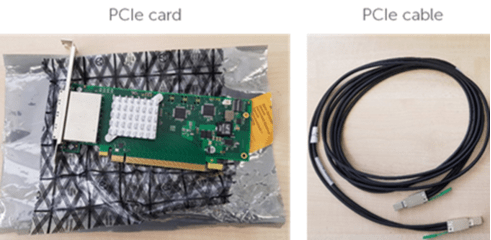
- The USB 3.2 interface card allows you to use high-speed USB ports with your computer, and we recommend only using the supplied USB interface card, rather than the existing USB ports on your computer. Please bear in mind only the PCIe interface can operate the Kinetix22 at maximum speeds.
- Two USB cables are included, a 90 cm A-C cable and a 3 m C-C cable. The Kinetix22 has a USB C port, so we give you the choice of USB A or C at the PC end.
- The USB C-C cable is uni-directional, and only works when the blue end (host) is plugged into the PC and the red end (sink) is plugged into the Kinetix.
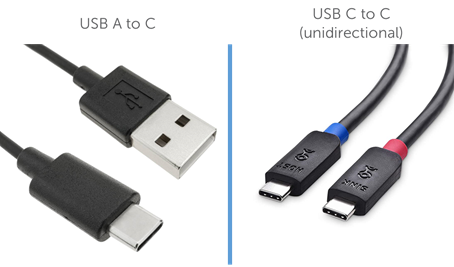
- The BNC cable is used for advanced hardware triggering, it plugs into the back of the Kinetix22 and comes with eight different cables for input and output hardware triggering, typically used to synchronise your light source and camera
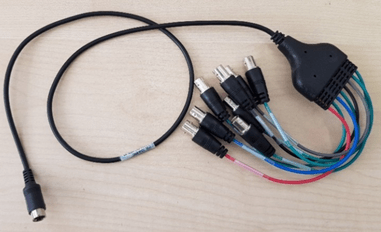
Setup
Now that you've performed your pre-arrival steps and got the box, it's time to get imaging! The setup comes in two main sections, hardware and software, and details everything you need to get the Kinetix22 up and running for your imaging experiments.
Software Setup
Teledyne Photometrics cameras use a driver known as PVCAM (Programmable Virtual Camera Access Method) to communicate with the computer. PVCAM must be installed on the host computer before the Kinetix22 can be used. The USB stick that comes in the box contains the latest version of PVCAM, or you can download it from our website: https://www.photometrics.com/support/download/pvcam.
In addition to the camera driver, PVCAM also contains two advanced imaging applications, PVCamTest and VersionInformation, the former allowing you to test the camera connection and take live images, and the latter reads firmware information, useful for technical support. Please note that PVCamTest is not software for acquiring images, and should be used for testing purposes only.
Start by installing PVCAM on your PC, either from the included USB stick or our website: https://www.photometrics.com/support/download/pvcam
Hardware Setup (for PCIe)
- Shut down and unplug your PC
- Open your PC case to access motherboard and PCIe slots (circled in white on image).
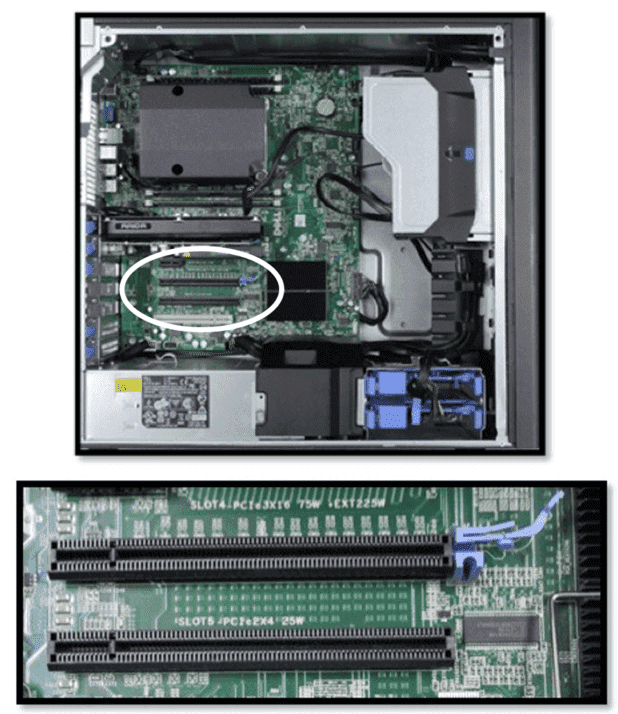
3. Locate an available x16 or x8 PCIe slot (x16 slots shown in the above image) and install the PCIe interface card, it should slide into place with minimal resistance, you will hear a click when fully inserted. The below image shows the PCIe card in an x16 slot (left) and an x8 slot (right, with overlapping pins).

4. Close your PC case and locate the newly available PCIe ports on the card.
5. Insert the PCIe cable into the top port (1) of the PCIe card. The cable in port 1 should then plug into the top port (1) of the Kinetix22.
6. Plug the power cable into the Kinetix22 and a suitable socket, then power on the Kinetix22. The initializing light will flash orange, once the flashing stops the Kinetix22 is ready.
7. Plug in and power on the PC
8. If the link between PC and Kinetix22 is successful, there will be a green LED light on the PCIe card. If the light is orange, make sure the cables are connected to the correct ports and are undamaged.
9. The link between PC and Kinetix22 can also be confirmed in software using PVCamTest (where you can run the camera live) or Device Manager (see if your PC has identified a PVCAM device).
If wanting to use a USB connection, install the included USB 3.2 interface card in the same manner as installing the included PCIe card. The Kinetix22 only requires one USB cable for operation, but will not operate at maximum speed.
Imaging In Software
The Kinetix22 is supported by a range of third-party imaging software provided by external organizations and companies, including MATLAB, Micro-Manager, LabVIEW, Open CV, Python, and more to come!
Micro-Manager
MicroManager (µManager) is open-source software for the control and automation of imaging hardware. µManager 2.0 is fully compatible with the Kinetix CMOS camera and can be downloaded at the following address:
https://micro-manager.org/Download_Micro-Manager_Latest_Release
µManager uses a configuration file to control the Kinetix22, here's how to get set up:
- Make sure the Kinetix22 and any additional imaging hardware is plugged in, turned on, and successfully connected to the PC.
2. Open µManager, when prompted for a Hardware Configuration File, select '(none)'.
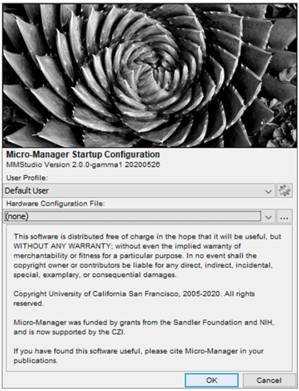
3. Under the 'Devices' dropdown menu, choose 'Hardware Configuration Wizard' and create a new configuration.
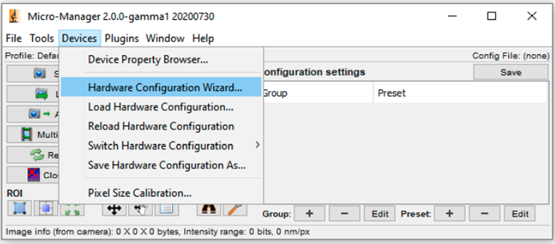
4. You'll see a list of available devices, go to PVCAM, select 'Camera-1', and click 'Add', then name the device.
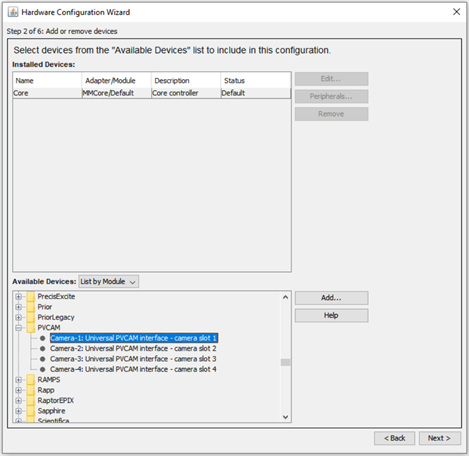
5. Add in any additional hardware such as motorized stages, light sources, etc. if needed.
6. Click through 'Next' to add and change additional hardware settings, please note that PVCAM devices need no additional settings changing at this stage.
7. Name and save your Hardware Configuration File and put it in an easy to access location, as you'll need to select this .config file every time you open µManager.
8. The Kinetix22 is now set up in µManager and you can use the basic functions, such as changing the exposure and starting an acquisition (in the red square below).
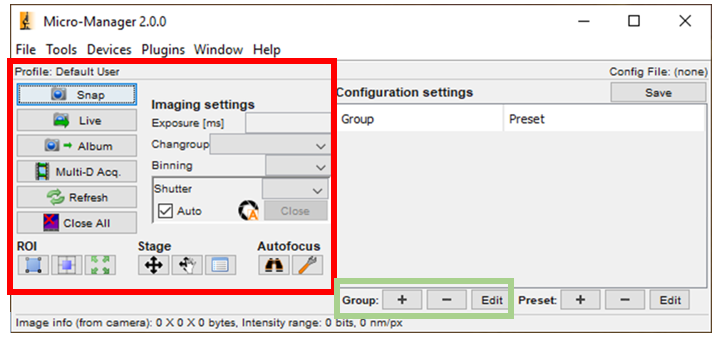
9. For Kinetix22 specific settings, it is necessary to add 'Groups' for each desired setting.
10. Click the plus symbol next to Group (green square on above figure) to see a list of all available hardware settings for the Kinetix.
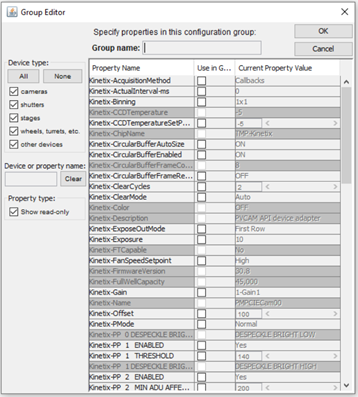
11. We recommend first adding 'Ports' as this allows access to the four modes of the Kinetix, namely Speed, Sensitivity, Dynamic Range, and Sub-Electron.
12. Select the 'Use in Group' tick box, name the Group, click OK, this adds the Group to the µManager window.
13. Add any other relevant Groups for settings you wish to control, such as fan speed, scan direction, triggering, and more.
14. You will also need to add Groups to control aspects of your other imaging hardware (if included in the config file), such as channels for your light source, etc.
15. By saving the config file, all your Groups will be preserved for the next time you open µManager.
16. See our full guide on what you can do with µManager here:
https://www.photometrics.com/wp-content/uploads/2020/11/How-to-use-Micro-Manager-Rev-A2-03112020.pdf
Troubleshooting
- Why isn't my Kinetix22 running at maximum speed in Speed Mode?
In order to get the full 500 fps across the full frame in 8-bit Speed Mode, you will need to use the PCIe connection with a sufficiently powerful PC. The PC can be a limiting factor with the Kinetix22, so it is vital to have enough RAM and a modern CPU. It is also vital to consider software limitations and update to the latest drivers.
Using USB and/or a PC with older parts will limit the data rate of the Kinetix22, meaning full speed will not be achievable. In addition, if you don't have enough RAM, even opening other applications can limit the bandwidth available for the Kinetix22, and in turn, limit the maximum achievable speed.
If you are using PCIe with a modern PC and still not getting the full speeds, check your imaging settings and exposure time. The 8-bit Speed Mode is needed for the maximum speeds, and in order to achieve >1000 fps (>1 kHz), it is necessary to use an exposure time of 1 ms or less.
- I have an orange light on my PCIe card
When successfully connecting the Kinetix22 and your host PC, the PCIe card will display a green LED light. If the light is orange it means there is an issue with the connection.
Ensure that the PCIe cable is fully inserted on both the PCIe card and the Kinetix22. If removing the cable to reattach, remember to pull on the green tab, not the wire itself.
Check that the cable is plugged into the top port (1) on the PCIe card, and the cable corresponds to the same port (1) on the Kinetix22. If the light is still orange, try port 3 on the card. Once you find an orientation that works, mark the cable. Finally, ensure that the camera was turned on and fully initialized before the PC was turned on.